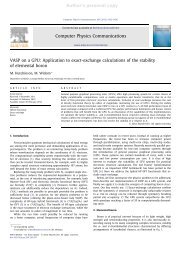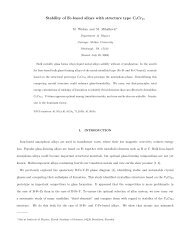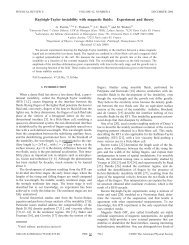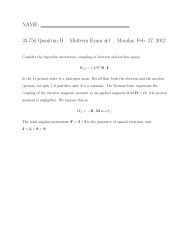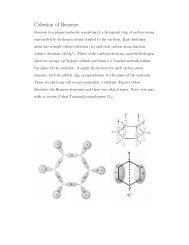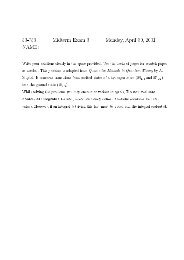X-ray diffuse scattering in the icosahedral quasicrystal Al-Pd-Mn
X-ray diffuse scattering in the icosahedral quasicrystal Al-Pd-Mn
X-ray diffuse scattering in the icosahedral quasicrystal Al-Pd-Mn
You also want an ePaper? Increase the reach of your titles
YUMPU automatically turns print PDFs into web optimized ePapers that Google loves.
PHYSICAL REVIEW B 66, 104202 2002<br />
X-<strong>ray</strong> <strong>diffuse</strong> <strong>scatter<strong>in</strong>g</strong> <strong>in</strong> <strong>the</strong> <strong>icosahedral</strong> <strong>quasicrystal</strong> <strong>Al</strong>-<strong>Pd</strong>-<strong>Mn</strong><br />
Y. Zhang, 1 S. N. Ehrlich, 2 R. Colella, 1, * M. Kopecky, 3 and M. Widom 4<br />
1 Department of Physics, Purdue University, West Lafayette, Indiana 47907-1396<br />
2 Brookhaven National Laboratory, NSLS, Upton, New York 11973<br />
3 S<strong>in</strong>crotrone Trieste, SS 14-Km 163.5, Area Science Park, 34012 Basovizza - Trieste, Italy<br />
4 Department of Physics, Carnegie Mellon University, Pittsburgh, Pennsylvania 15213<br />
Received 20 December 2001; published 19 September 2002<br />
Several iso<strong>in</strong>tensity contour plots of <strong>diffuse</strong> <strong>scatter<strong>in</strong>g</strong> around Bragg reflections have been obta<strong>in</strong>ed at 300<br />
and 20 K on planar sections of reciprocal space perpendicular to twofold axes. The geometry of <strong>the</strong> experiments<br />
was such that circular contours were expected on <strong>the</strong> basis of elastic isotropy, demonstrated by <strong>the</strong> speed<br />
of sound be<strong>in</strong>g uniform <strong>in</strong> all directions. Instead, <strong>the</strong> profiles were markedly elongated along a twofold axis, a<br />
direct <strong>in</strong>dication of <strong>scatter<strong>in</strong>g</strong> due to phason fluctuations. The 1/q 2 dependence of <strong>diffuse</strong> <strong>scatter<strong>in</strong>g</strong> was<br />
verified <strong>in</strong> <strong>the</strong> neighborhood of <strong>the</strong> (0 4604¯6) Bragg reflection, but not near <strong>the</strong> (5 33311¯), a possible<br />
<strong>in</strong>dication of lack of equilibrium <strong>in</strong> <strong>the</strong> phason fluctuations.<br />
DOI: 10.1103/PhysRevB.66.104202<br />
PACS numbers: 61.44.Br<br />
I. INTRODUCTION<br />
A perfectly periodic crystal, without lattice defects such<br />
as vacancies, <strong>in</strong>terstitials, dislocations, <strong>the</strong>rmal motion, etc.,<br />
does not produce any <strong>diffuse</strong> <strong>scatter<strong>in</strong>g</strong>. The diffraction pattern<br />
of such a crystal consists of sharp and narrow Bragg<br />
peaks, and no <strong>scatter<strong>in</strong>g</strong> is visible between Bragg peaks.<br />
Strictly speak<strong>in</strong>g, this statement is true for coherent <strong>scatter<strong>in</strong>g</strong>.<br />
If <strong>in</strong>coherent <strong>scatter<strong>in</strong>g</strong> is present, such as Compton<br />
<strong>scatter<strong>in</strong>g</strong> <strong>in</strong> <strong>the</strong> case of x <strong>ray</strong>s, a cont<strong>in</strong>uous background<br />
may be present, whose variations <strong>in</strong> reciprocal space are<br />
quite smooth and do not correlate with <strong>the</strong> positions of <strong>the</strong><br />
atoms <strong>in</strong> <strong>the</strong> crystal. Compton <strong>scatter<strong>in</strong>g</strong> is also <strong>in</strong>elastic, so<br />
it can be removed, at least <strong>in</strong> pr<strong>in</strong>ciple, by an energy analysis.<br />
Even <strong>the</strong> most perfect crystals, such as silicon and germanium,<br />
with essentially no lattice defects, exhibit an appreciable<br />
amount of <strong>diffuse</strong> <strong>scatter<strong>in</strong>g</strong>. This is due to <strong>the</strong>rmal<br />
vibrations, which cause <strong>the</strong> crystal to appear disordered. In<br />
fact, <strong>the</strong> time of flight of each <strong>in</strong>dividual x-<strong>ray</strong> photon<br />
through <strong>the</strong> crystal is much smaller than <strong>the</strong> period of <strong>the</strong>rmal<br />
vibrations, so every phonon ‘‘sees’’ a different crystal, <strong>in</strong><br />
which most of <strong>the</strong> atoms are out of <strong>the</strong>ir lattice positions.<br />
Thermal <strong>diffuse</strong> <strong>scatter<strong>in</strong>g</strong> TDS is temperature dependent,<br />
and is present even at T0 K, due to <strong>the</strong> zero po<strong>in</strong>t energy.<br />
In a perfect crystal such as silicon or germanium TDS<br />
would be <strong>the</strong> only source of <strong>diffuse</strong> <strong>scatter<strong>in</strong>g</strong> apart from<br />
Compton <strong>scatter<strong>in</strong>g</strong>. But <strong>in</strong> a <strong>quasicrystal</strong> <strong>the</strong> situation is<br />
quite different because <strong>the</strong>re is no periodicity, and some lattice<br />
disorder is present as an <strong>in</strong>herent feature of <strong>the</strong> crystal<br />
structure, which exhibits sharp Fourier components even <strong>in</strong><br />
<strong>the</strong> absence of periodicity.<br />
We decided to concentrate on <strong>icosahedral</strong> <strong>Al</strong>-<strong>Pd</strong>-<strong>Mn</strong>, because<br />
it is a very ‘‘perfect’’ <strong>quasicrystal</strong>, <strong>in</strong> <strong>the</strong> sense that it<br />
produces x-<strong>ray</strong> rock<strong>in</strong>g curves extremely sharp 15–30 arcsec,<br />
comparable to those produced by germanium and silicon.<br />
S<strong>in</strong>ce <strong>diffuse</strong> <strong>scatter<strong>in</strong>g</strong> is quite sensitive to <strong>the</strong> atomic<br />
locations, we hope that this work will be useful for evaluat<strong>in</strong>g<br />
models which specify atomic locations <strong>in</strong> <strong>quasicrystal</strong>s.<br />
Our work is meant to expand and complement o<strong>the</strong>r <strong>diffuse</strong><br />
<strong>scatter<strong>in</strong>g</strong> studies that have appeared recently <strong>in</strong> <strong>the</strong> literature<br />
of <strong>quasicrystal</strong>s. Previous studies of x-<strong>ray</strong> <strong>diffuse</strong><br />
<strong>scatter<strong>in</strong>g</strong> <strong>in</strong> <strong>icosahedral</strong> structures were done <strong>in</strong> an <strong>Al</strong>-Cu-Fe<br />
<strong>quasicrystal</strong>, <strong>the</strong> first high quality material that could be obta<strong>in</strong>ed<br />
<strong>in</strong> large size. 1,2 Extensive <strong>in</strong>vestigations of <strong>diffuse</strong><br />
<strong>scatter<strong>in</strong>g</strong> from <strong>the</strong> <strong>icosahedral</strong> phase of <strong>Al</strong>-<strong>Pd</strong>-<strong>Mn</strong> were performed<br />
by de Boissieu et al., 3 us<strong>in</strong>g elastic neutron <strong>scatter<strong>in</strong>g</strong>.<br />
This <strong>scatter<strong>in</strong>g</strong>, close to Bragg reflections, was mostly<br />
due to phason disorder. <strong>Al</strong>l data could be <strong>in</strong>terpreted by mak<strong>in</strong>g<br />
use of <strong>the</strong> elastic <strong>the</strong>ory of <strong>quasicrystal</strong>s, with two elastic<br />
constants. Detailed x-<strong>ray</strong> studies were performed more recently<br />
by Capitan et al., 4 <strong>in</strong> which <strong>the</strong> effect of stoichiometry<br />
was <strong>in</strong>vestigated <strong>in</strong> detail.<br />
More recently, Létoublon et al. fur<strong>the</strong>r <strong>in</strong>vestigated <strong>the</strong><br />
nature of <strong>diffuse</strong> <strong>scatter<strong>in</strong>g</strong> <strong>in</strong> <strong>Al</strong>-<strong>Pd</strong>-<strong>Mn</strong> by x-<strong>ray</strong> and neutron<br />
<strong>scatter<strong>in</strong>g</strong>, 5 and placed <strong>the</strong>ir <strong>in</strong>tensity measurements on<br />
an absolute scale, <strong>in</strong> order to obta<strong>in</strong> <strong>the</strong> numerical values of<br />
<strong>the</strong> phason elastic constants. They also showed that <strong>diffuse</strong><br />
<strong>scatter<strong>in</strong>g</strong> does not depend on lattice defects.<br />
II. EXPERIMENT<br />
The sample was <strong>the</strong> same as that used <strong>in</strong> a separate <strong>diffuse</strong><br />
<strong>scatter<strong>in</strong>g</strong> experiment <strong>in</strong> which use was made of an imag<strong>in</strong>g<br />
plate as a detector. 6 A detailed description of <strong>the</strong> specimen<br />
was given <strong>in</strong> Ref. 6, and it is partially reproduced here. The<br />
sample was a th<strong>in</strong> slice of <strong>Al</strong> 71.0 <strong>Pd</strong> 20.5 <strong>Mn</strong> 8.5 cut perpendicular<br />
to a twofold axis with<strong>in</strong> 0.25°), and diamond polished on<br />
both sides. The thickness was 0.385 mm, as measured with a<br />
micrometer. A perfect region was selected, <strong>in</strong> which a synchrotron<br />
beam from a perfect Si crystal monochromator<br />
would produce a sharp diffraction peak with no apparent<br />
broaden<strong>in</strong>g about 20 arcsec wide or less. To make sure that<br />
<strong>the</strong> same crystal region was used <strong>in</strong> all experiments, <strong>the</strong> crystal<br />
was set aga<strong>in</strong>st a thick copper plate with a 1.5-mm hole.<br />
The crystal and its specimen holder were placed <strong>in</strong>side of a<br />
closed circle refrigerator. We took two sets of data, at room<br />
temperature 300 K and at 20 K. <strong>Al</strong>l data described <strong>in</strong> this<br />
paper were taken at <strong>the</strong> National Synchrotron Light Source<br />
NSLS of Brookhaven National Laboratory, on beam l<strong>in</strong>e<br />
0163-1829/2002/6610/1042027/$20.00<br />
66 104202-1<br />
©2002 The American Physical Society
ZHANG, EHRLICH, COLELLA, KOPECKY, AND WIDOM<br />
PHYSICAL REVIEW B 66, 104202 2002<br />
FIG. 1. Experimental contour profiles of <strong>diffuse</strong> <strong>scatter<strong>in</strong>g</strong> on<br />
<strong>the</strong> (k,l) plane. Units for <strong>the</strong> (hkl) axes are <strong>in</strong> Å 1 . The Bragg<br />
reflection (4 604¯6 0) is at <strong>the</strong> center of <strong>the</strong> plot. The numbers are<br />
<strong>in</strong>tensities <strong>in</strong> arbitrary units, on a logarithmic scale base 2.<br />
X18-A. The <strong>in</strong>cident x-<strong>ray</strong> beam size was less than 1.0<br />
1.0 mm 2 . The x-<strong>ray</strong> energy was 17.4 KeV, correspond<strong>in</strong>g<br />
to Mo-K, (0.711 Å). Polaroid photos were taken upstream<br />
and downstream with respect to <strong>the</strong> sample, to make<br />
sure that <strong>the</strong> x-<strong>ray</strong> beam was not blocked even partially by<br />
<strong>the</strong> sample holder for every change of orientation. <strong>Al</strong>l measurements<br />
were taken <strong>in</strong> a transmission geometry. A sc<strong>in</strong>tillation<br />
detector was used throughout all measurements. Typical<br />
scans were planar scans, on planes perpendicular to a<br />
twofold axis, <strong>in</strong> <strong>the</strong> neighborhood of a strong Bragg reflection,<br />
<strong>the</strong> (4 604¯6 0) (Q x 0.790, Q y 0.0, Q z 0.0; M<br />
336; N208). The conventions on <strong>the</strong> sixfold Miller <strong>in</strong>dices<br />
notation, and <strong>the</strong> conversion to a three-dimensional<br />
3D reciprocal lattice, are those of Ref. 7. A reciprocal lattice<br />
vector Q is given by Q2 s<strong>in</strong> /. A typical 2D scan<br />
across <strong>the</strong> plane Q x 0.790 Å 1 , at room temperature, is<br />
shown <strong>in</strong> Fig. 1. A very similar plot was obta<strong>in</strong>ed at 20 K. As<br />
we depart a little from <strong>the</strong> Bragg reflection, (Q x<br />
0.793 Å 1 and Q x 0.003 Å 1 ), <strong>the</strong> isodiffusion contour<br />
profiles keep <strong>the</strong> same shape, albeit with a weaker <strong>in</strong>tensity<br />
Fig. 2. A plot taken at Q x 0.003 Å 1 not<br />
shown here is almost identical. While <strong>the</strong> earlier studies of<br />
<strong>diffuse</strong> <strong>scatter<strong>in</strong>g</strong> <strong>in</strong> <strong>quasicrystal</strong>s 1,3–5 were done <strong>in</strong> <strong>the</strong><br />
neighborhood of Bragg reflections, <strong>in</strong> this work we explored<br />
regions of <strong>the</strong> reciprocal space at some distance from <strong>the</strong><br />
Bragg spots.<br />
As we depart more from <strong>the</strong> Bragg reflection, <strong>the</strong> profiles<br />
acquire different shapes and <strong>the</strong> overall <strong>in</strong>tensity becomes<br />
weaker and weaker. Figure 3, for example, corresponds to<br />
<strong>the</strong> plane Q x 0.781 Å 1 (Q x 0.009 Å 1 ) and Fig. 4<br />
corresponds to <strong>the</strong> plane Q x 0.798 Å 1 (Q x <br />
0.008 Å 1 ). Notice <strong>the</strong> lack of symmetry <strong>in</strong> <strong>the</strong> <strong>diffuse</strong><br />
<strong>scatter<strong>in</strong>g</strong> around <strong>the</strong> Bragg reflection, for relatively large<br />
FIG. 2. The same as Fig. 1, except that <strong>the</strong> (k,l) plane is slightly<br />
off <strong>the</strong> Bragg reflection (Q x 0.003 Å 1 ).<br />
values of Q x . Such a lack of symmetry was not observed<br />
<strong>in</strong> proximity of <strong>the</strong> Bragg reflection. The same plots taken at<br />
20 K were almost identical, except for a small <strong>in</strong>crease of<br />
<strong>in</strong>tensity, <strong>in</strong> rough agreement with a change <strong>in</strong> <strong>the</strong> Debye-<br />
Waller factor. 8<br />
III. DISCUSSION<br />
<strong>Al</strong>l scans on planes perpendicular to <strong>the</strong> Q x direction<br />
clearly show a twofold symmetry. This is to be expected,<br />
because <strong>the</strong> Q x direction is a twofold axis. Let G be <strong>the</strong><br />
FIG. 3. The same as Figs. 1 and 2, except that Q x <br />
0.009 Å 1 .<br />
104202-2
X-RAY DIFFUSE SCATTERING IN THE ICOSAHEDRAL ...<br />
PHYSICAL REVIEW B 66, 104202 2002<br />
v l c 11 /,<br />
2<br />
where is <strong>the</strong> density of <strong>the</strong> material and v l is <strong>the</strong> longitud<strong>in</strong>al<br />
velocity, and two degenerate solutions correspond<strong>in</strong>g<br />
to transverse waves of arbitrary polarizations:<br />
v t c 44 /<br />
3<br />
where v t is <strong>the</strong> transverse, or shear velocity. Consider now<br />
<strong>the</strong> expression for <strong>the</strong> first order x-<strong>ray</strong> <strong>diffuse</strong> <strong>scatter<strong>in</strong>g</strong> <strong>in</strong>tensity,<br />
at a given po<strong>in</strong>t P <strong>in</strong> reciprocal space, for an isotropic<br />
monoatomic crystal. It can be derived from Eq. 11.36 of<br />
Ref. 14. A similar expression for <strong>quasicrystal</strong>s is given <strong>in</strong><br />
Ref. 15. The expression given here has been adapted to <strong>the</strong><br />
experimental conditions under which <strong>the</strong> contour plot of Fig.<br />
1 has been obta<strong>in</strong>ed.<br />
I 1 S/ f 2 e kT 2M<br />
V c m<br />
• S2 / 2<br />
,<br />
q 2<br />
cos2 <br />
v l<br />
2<br />
s<strong>in</strong>2 <br />
v t<br />
2 <br />
4<br />
FIG. 4. The same as Figs. 1 and 2, except that Q x<br />
0.008 Å 1 .<br />
magnitude of <strong>the</strong> (4 604¯6 0) reciprocal lattice vector<br />
(0.790 Å 1 ). The <strong>scatter<strong>in</strong>g</strong> vector <strong>in</strong> our setup was perpendicular<br />
to <strong>the</strong> Q x G plane, when <strong>the</strong> Bragg reflection<br />
(4604¯6 0) was excited, which would correspond to <strong>the</strong><br />
central po<strong>in</strong>t of Fig. 1. The <strong>scatter<strong>in</strong>g</strong> vector was almost perpendicular<br />
to <strong>the</strong> plane of Fig. 1 at any o<strong>the</strong>r po<strong>in</strong>t of <strong>the</strong><br />
figure. For example, <strong>the</strong> angle of <strong>the</strong> <strong>scatter<strong>in</strong>g</strong> vector with<br />
<strong>the</strong> plane of Fig. 1 would be about 88° at any of <strong>the</strong> four<br />
corners of <strong>the</strong> figure. It is <strong>the</strong>n clear that <strong>the</strong> angle between<br />
<strong>the</strong> <strong>scatter<strong>in</strong>g</strong> vector and <strong>the</strong> plane of Fig. 1 is constant on<br />
any circular contour centered at <strong>the</strong> center, such as that<br />
shown <strong>in</strong> <strong>the</strong> figure.<br />
Icosahedral <strong>quasicrystal</strong>s are considered to be elastically<br />
isotropic, as a result of <strong>the</strong>ir symmetry properties. In fact, <strong>the</strong><br />
speed of sound has been measured <strong>in</strong> several directions and<br />
found to be uniform with<strong>in</strong> 100 parts per million. 9 Now, we<br />
know that <strong>the</strong> elastic properties of an isotropic medium can<br />
be described by means of two elastic constants, for example,<br />
<strong>the</strong> longitud<strong>in</strong>al and <strong>the</strong> shear speeds of sound. For <strong>quasicrystal</strong>s,<br />
this has been shown by several authors. 10–12 We will<br />
adopt <strong>the</strong> view, <strong>in</strong> this paper, that <strong>quasicrystal</strong>s can be described<br />
as isotropic media. For example, <strong>the</strong>y can be described<br />
as crystals hav<strong>in</strong>g cubic symmetry, <strong>in</strong> which <strong>the</strong> condition<br />
for isotropy,<br />
c 11 c 12 2c 44 ,<br />
is satisfied. In fact, symmetry operations like those that lead<br />
to a reduction <strong>in</strong> <strong>the</strong> number of elastic constants, from 21 for<br />
a general solid with no symmetry, to 3 for a solid with cubic<br />
symmetry, can be used for a solid with <strong>icosahedral</strong> symmetry<br />
to reduce <strong>the</strong> number to 2. In <strong>the</strong> case of an isotropic solid,<br />
<strong>the</strong> dynamical equations for sound waves for example, Eqs.<br />
10.9 <strong>in</strong> Ref. 13 are simplified, and for any wave vector k<br />
<strong>the</strong>re is one solution correspond<strong>in</strong>g to a longitud<strong>in</strong>al wave,<br />
1<br />
where SVˆ sVˆ 0 ; Vˆ 0 is <strong>the</strong> <strong>in</strong>cident beam unit vector; Vˆ S is<br />
<strong>the</strong> scattered beam unit vector; is <strong>the</strong> wavelength of <strong>the</strong> x<br />
<strong>ray</strong>s; f is <strong>the</strong> atomic <strong>scatter<strong>in</strong>g</strong> factor; e 2M is <strong>the</strong> Debye-<br />
Waller factor; k is <strong>the</strong> Boltzmann constant; v l is <strong>the</strong> longitud<strong>in</strong>al<br />
sound velocity; v t is <strong>the</strong> transverse sound velocity; T is<br />
<strong>the</strong> temperature; V c is <strong>the</strong> volume of <strong>the</strong> unit cell; m is <strong>the</strong><br />
atomic mass; q is <strong>the</strong> phonon wave vector, issued at Bragg<br />
reflection, term<strong>in</strong>at<strong>in</strong>g at po<strong>in</strong>t PS/G ; and is <strong>the</strong><br />
angle between S and q.<br />
Consider now a po<strong>in</strong>t P on a circumference of arbitrary<br />
radius centered on <strong>the</strong> Bragg reflection <strong>in</strong> Fig. 1. As we go<br />
around <strong>the</strong> circle, <strong>the</strong> Q magnitude and <strong>the</strong> velocities v l and<br />
v t are constant. Therefore, <strong>the</strong> <strong>in</strong>tensity is <strong>the</strong> same at any<br />
po<strong>in</strong>t on <strong>the</strong> circle. This would not be true <strong>in</strong> <strong>the</strong> plots of Ref.<br />
3. It can easily be shown that second order <strong>diffuse</strong> <strong>scatter<strong>in</strong>g</strong><br />
two-phonon <strong>scatter<strong>in</strong>g</strong> is also expected to be isotropic see<br />
Sec. 1.6 <strong>in</strong> Ref. 14. An example of an isotropic solid giv<strong>in</strong>g<br />
circular contours of <strong>diffuse</strong> <strong>scatter<strong>in</strong>g</strong> is that of tungsten. 16<br />
It is <strong>the</strong>refore somewhat surpris<strong>in</strong>g to see <strong>the</strong> contours of<br />
Fig. 1 def<strong>in</strong>itely depart<strong>in</strong>g from a circular shape. The reason<br />
for this is that a large fraction of <strong>diffuse</strong> <strong>scatter<strong>in</strong>g</strong> is due to<br />
phasons, whose velocities are not supposed to be isotropic.<br />
The departure from circular symmetry visible <strong>in</strong> Fig. 1<br />
can <strong>the</strong>refore be directly connected with <strong>the</strong> existence of<br />
phasons <strong>in</strong> <strong>Al</strong>-<strong>Pd</strong>-<strong>Mn</strong>, which can <strong>in</strong>deed produce anisotropic<br />
<strong>diffuse</strong> <strong>scatter<strong>in</strong>g</strong>, 15 as proved by <strong>the</strong> anisotropic ultrasonic<br />
attenuation observed by Amazit et al. 9 The question may be<br />
asked whe<strong>the</strong>r or not this lack of circular symmetry can also<br />
be observed around o<strong>the</strong>r Bragg reflections.<br />
In a separate experiment, described <strong>in</strong> Ref. 6, we took<br />
<strong>diffuse</strong> <strong>scatter<strong>in</strong>g</strong> data us<strong>in</strong>g a technique called <strong>the</strong> ‘‘monochromatic<br />
Laue method.’’ This method simply consists of<br />
keep<strong>in</strong>g a crystal stationary on a monochromatic x-<strong>ray</strong> beam,<br />
and record<strong>in</strong>g <strong>the</strong> diffraction pattern on a flat film, <strong>in</strong> our<br />
case, an imag<strong>in</strong>g plate perpendicular to <strong>the</strong> <strong>in</strong>cident beam,<br />
placed downstream with respect to <strong>the</strong> crystal. In this way,<br />
each image corresponds to a spherical cap <strong>in</strong> reciprocal space<br />
be<strong>in</strong>g projected on a plane. Three-dimensional regions of<br />
104202-3
ZHANG, EHRLICH, COLELLA, KOPECKY, AND WIDOM<br />
PHYSICAL REVIEW B 66, 104202 2002<br />
<strong>the</strong> profiles <strong>in</strong> Fig. 5 are very similar to those of Fig. 1. This<br />
phason <strong>scatter<strong>in</strong>g</strong> is present around all Bragg reflections,<br />
most likely. This example shows <strong>the</strong> power and <strong>the</strong> convenience<br />
of image plates as two-dimensional detectors. Sizable<br />
three-dimensional regions of reciprocal space can be scanned<br />
<strong>in</strong> m<strong>in</strong>utes, as opposed to <strong>the</strong> hours needed to obta<strong>in</strong> twodimensional<br />
scans such as those of Figs. 1–5, obta<strong>in</strong>ed by<br />
count<strong>in</strong>g po<strong>in</strong>t by po<strong>in</strong>t, us<strong>in</strong>g a sc<strong>in</strong>tillation counter.<br />
IV. COMPARISON WITH THEORY<br />
FIG. 5. Contour profiles of <strong>diffuse</strong> <strong>scatter<strong>in</strong>g</strong> on <strong>the</strong> (k,l) plane.<br />
The Bragg reflection (2¯4¯ 024¯0) is at <strong>the</strong> center of <strong>the</strong> plot. Data<br />
taken with imag<strong>in</strong>g plate, us<strong>in</strong>g <strong>the</strong> monochromatic Laue method.<br />
reciprocal space can be explored by rotat<strong>in</strong>g <strong>the</strong> crystal<br />
around an axis perpendicular to <strong>the</strong> <strong>in</strong>cident beam. Data were<br />
taken <strong>in</strong> several million data po<strong>in</strong>ts. Two-dimensional scans<br />
on given planes <strong>in</strong> reciprocal space were <strong>the</strong>n obta<strong>in</strong>ed by<br />
<strong>in</strong>terpolation. Figure 5 shows a typical contour plot around<br />
<strong>the</strong> (2¯4¯ 024¯0) Bragg reflection, also located on a twofold<br />
axis, with Q x 0.4882, Q y 0.0, Q z 0.0, M128, and<br />
N80. It is clear that <strong>the</strong> asymmetry persists. The shapes of<br />
S<strong>in</strong>ce <strong>the</strong> oval shapes of <strong>the</strong> iso-<strong>in</strong>tensity contour plots <strong>in</strong><br />
Figs. 1 and 2 cannot be produced by phonon <strong>scatter<strong>in</strong>g</strong>,<br />
which would generate circular plots, we will attempt to analyze<br />
<strong>the</strong> data <strong>in</strong> Figs. 1–4 <strong>in</strong> terms of phason <strong>scatter<strong>in</strong>g</strong>.<br />
Compton <strong>scatter<strong>in</strong>g</strong> is also neglected <strong>in</strong> this analysis, because<br />
it is ra<strong>the</strong>r uniform over <strong>the</strong> regions depicted <strong>in</strong> Figs. 1–4.<br />
Diffuse <strong>scatter<strong>in</strong>g</strong> from equilibrium phason fluctuations<br />
are governed by <strong>the</strong> form of <strong>the</strong> elastic free energy. 2,15,7 If we<br />
represent by w(q) <strong>the</strong> Fourier amplitude of a phason mode<br />
with wavevector q(q x ,q y ,q z ), <strong>the</strong>n <strong>the</strong> phason elastic free<br />
energy is<br />
F 1 2 dq<br />
2 3 wq•Cq•wq, 5<br />
where <strong>the</strong> ‘‘hydrodynamic matrix’’ C(q)K 1 C 1 (q)<br />
K 2 C 2 (q) with<br />
C 1 qq2 0 0<br />
2<br />
0 q 2 0<br />
6<br />
0 0 q<br />
and<br />
C 2 qq2 /3q 2 2<br />
y /q z 2q x q y 2q x q z<br />
2q y q x q 2 /3q 2 2<br />
z /q x 2q y q z<br />
7<br />
2q z q x 2q z q y q 2 /3q 2 x /q<br />
2. y<br />
<strong>Al</strong>though <strong>the</strong> current experiments have been performed at<br />
T300 K, and <strong>the</strong> phasons are presumably not <strong>in</strong> <strong>the</strong>rmal<br />
equilibrium, we suppose that <strong>the</strong>y are frozen <strong>in</strong>to a configuration<br />
representative of equilibrium at some higher temperature.<br />
The <strong>diffuse</strong> <strong>scatter<strong>in</strong>g</strong> <strong>in</strong>tensity can be derived from <strong>the</strong><br />
free energy Eq. 5 through Gaussian <strong>in</strong>tegration. 2,15,17 The<br />
result<strong>in</strong>g <strong>diffuse</strong> <strong>in</strong>tensity at <strong>the</strong> po<strong>in</strong>t Q G q is proportional<br />
to<br />
I G qG •C 1 q•G .<br />
Here G is a Bragg peak position, and G is its perpendicular<br />
space component. For <strong>the</strong> (4 6 0 4¯6 0) and (2¯4¯ 024¯0)<br />
peaks, both G and G lie along <strong>the</strong> x direction. Hence <strong>the</strong>ir<br />
8<br />
<strong>in</strong>tensities are given by <strong>the</strong> ‘‘11’’ element of C 1 . In <strong>the</strong><br />
plane perpendicular to G we set q x 0. The <strong>diffuse</strong> <strong>in</strong>tensity<br />
is <strong>the</strong>n<br />
I G q y ,q z <br />
G 2<br />
<br />
K 1 q 2 y q 2 z K 2 1/31/q 2 y 1/3q 2 z .<br />
Figure 6 shows contours of this function. We set<br />
K2/K10.65, a value slightly closer to <strong>the</strong> <strong>in</strong>stability at<br />
K2/K13/4 than reported <strong>in</strong> prior experiments by de Bois-<br />
9<br />
104202-4
X-RAY DIFFUSE SCATTERING IN THE ICOSAHEDRAL ...<br />
PHYSICAL REVIEW B 66, 104202 2002<br />
FIG. 8. Diffuse <strong>scatter<strong>in</strong>g</strong> near a Bragg reflection: <strong>the</strong><br />
(04604¯6). Its coord<strong>in</strong>ates <strong>in</strong> reciprocal space are Q x 0, Q y<br />
0, and Q z 0.78995 Å 1 . This was a scan along a straight l<strong>in</strong>e<br />
go<strong>in</strong>g through <strong>the</strong> Bragg reflection and <strong>the</strong> orig<strong>in</strong> a -2 scan.<br />
Low-Q side. Values on abscissa are distances from <strong>the</strong> orig<strong>in</strong> <strong>in</strong><br />
reciprocal space.<br />
FIG. 6. Diffuse <strong>scatter<strong>in</strong>g</strong> plot on <strong>the</strong> (k,l) plane. The Bragg<br />
reflection (4 604¯6 0) is at <strong>the</strong> center of <strong>the</strong> plot. Units for <strong>the</strong><br />
(hkl) axes are <strong>in</strong> Å 1 . Calculated from elasticity <strong>the</strong>ory.<br />
sieu et al. 3 Note <strong>the</strong> <strong>diffuse</strong> <strong>scatter<strong>in</strong>g</strong> contours are elongated<br />
<strong>in</strong> <strong>the</strong> q z direction, with an aspect ratio similar to that seen <strong>in</strong><br />
Figs. 1 and 5.<br />
As we depart from <strong>the</strong> Bragg reflection Figs. 3 and 4,<br />
<strong>the</strong> oval shape is lost. The calculated profile <strong>in</strong> Fig. 7 bears a<br />
strik<strong>in</strong>g resemblance with Fig. 4. We would be tempted to<br />
conclude that <strong>the</strong> agreement between <strong>the</strong>ory and experiment<br />
persists at some distance from <strong>the</strong> Bragg reflection. The<br />
problem is that <strong>the</strong> <strong>the</strong>ory predicts perfect symmetry with<br />
respect to <strong>the</strong> sign of q x . In o<strong>the</strong>r words, <strong>the</strong> <strong>in</strong>tensity given<br />
by <strong>the</strong> equation for I G (q y ,q z ) derived for q x 0 not given<br />
here is <strong>the</strong> same for q x . Such symmetry is <strong>in</strong>deed observed<br />
for planar plots located near <strong>the</strong> Bragg reflection<br />
(q x 0.003 Å 1 ). However, as we depart from <strong>the</strong> Bragg<br />
reflection Figs. 3 and 4, <strong>the</strong> plots look quite different. The<br />
q x values (0.009 and 0.008 differ <strong>in</strong> magnitude by an<br />
amount correspond<strong>in</strong>g to <strong>the</strong> experimental error. At <strong>the</strong> moment<br />
we have no explanation for <strong>the</strong> difference <strong>in</strong> <strong>the</strong> iso<strong>in</strong>tensity<br />
contour plots of Figs. 3 and 4. This subject deserves<br />
fur<strong>the</strong>r study.<br />
V. 1ÕQ 2 DEPENDENCE OF DIFFUSE SCATTERING<br />
Equation 4 shows that <strong>the</strong> <strong>diffuse</strong> <strong>scatter<strong>in</strong>g</strong> due to<br />
phonons should be proportional to 1/q 2 , where q is <strong>the</strong> phonon<br />
wave vector, def<strong>in</strong>ed by<br />
S/G q,<br />
10<br />
where S/ is <strong>the</strong> <strong>scatter<strong>in</strong>g</strong> vector and G is <strong>the</strong> Bragg reflection<br />
under consideration. The general formula 11.36 <strong>in</strong> Ref.<br />
14 does <strong>in</strong> fact predict a 1/q 2 dependence. Equation 4 was<br />
obta<strong>in</strong>ed under <strong>the</strong> assumption of elastic isotropy. The same<br />
result applies to <strong>quasicrystal</strong>s see Eq. 1.15 <strong>in</strong> Ref. 15.. Soit<br />
FIG. 7. The same as Fig. 6, except that <strong>the</strong> (k,l) plane is off <strong>the</strong><br />
Bragg reflection (Q x 0.008 Å 1 ).<br />
FIG. 9. The same as Fig. 8, except that this is <strong>the</strong> high-Q side.<br />
104202-5
ZHANG, EHRLICH, COLELLA, KOPECKY, AND WIDOM<br />
PHYSICAL REVIEW B 66, 104202 2002<br />
FIG. 10. Diffuse <strong>scatter<strong>in</strong>g</strong> near a Bragg reflection: <strong>the</strong><br />
(533311¯). Its coord<strong>in</strong>ates <strong>in</strong> reciprocal space are: Q x<br />
0.244 Å 1 , Q y 0.488 Å 1 , and Q z 0.151 Å 1 . This was a<br />
scan along a straight l<strong>in</strong>e go<strong>in</strong>g through <strong>the</strong> Bragg reflection and <strong>the</strong><br />
orig<strong>in</strong> a -2 scan. Low-Q side. Values on abscissa are distances<br />
from <strong>the</strong> orig<strong>in</strong> <strong>in</strong> reciprocal space. Best fit is obta<strong>in</strong>ed with 1/q ,<br />
with 2.240.03.<br />
is <strong>in</strong>terest<strong>in</strong>g to verify this po<strong>in</strong>t. To answer this question we<br />
explored <strong>the</strong> environment of two Bragg reflections. We performed<br />
-2 scans, which are along straight l<strong>in</strong>es <strong>in</strong> reciprocal<br />
space, go<strong>in</strong>g through <strong>the</strong> orig<strong>in</strong> and <strong>the</strong> relevant Bragg<br />
reflection. Portions of <strong>the</strong> scans are shown <strong>in</strong> Figs. 8 and 9.<br />
The relevant Bragg reflection is <strong>the</strong> (04604¯6; M336,<br />
N208. The Q components are Q x 0.0, Q y 0.0, and Q z<br />
0.790 Å 1 . It is one of <strong>the</strong> strongest reflections, with Q <br />
0.0272 Å 1 . The variable <strong>in</strong> abscissa is <strong>the</strong> magnitude of<br />
<strong>the</strong> <strong>scatter<strong>in</strong>g</strong> vector QS/. The two figures correspond<br />
to <strong>the</strong> two sides of <strong>the</strong> Bragg reflection. The solid l<strong>in</strong>es represent<br />
fits to a 1/q function. The exponent is found to be<br />
1.9230.020 on <strong>the</strong> low G side, and 2.0770.012 on <strong>the</strong><br />
high G side. It is not clear whe<strong>the</strong>r or not <strong>the</strong> difference <br />
2 is significant. The 1/q 2 behavior seems to be well established<br />
around <strong>the</strong> (0 4604¯6) Bragg reflection.<br />
However, if we look at <strong>the</strong> environment of ano<strong>the</strong>r Bragg<br />
reflection, <strong>the</strong> (5 33311¯), where M172 and N108, <strong>the</strong><br />
situation is quite different. It is a ra<strong>the</strong>r weak reflection. The<br />
Q components are Q x 0.244 Å 1 , Q y 0.488 Å 1 , Q z<br />
0.151 Å 1 , Q 0.566 Å 1 , and Q 0.0608 Å 1 . Figures<br />
10 and 11 aga<strong>in</strong> show <strong>the</strong> low and high values of Q, <strong>the</strong><br />
<strong>scatter<strong>in</strong>g</strong> vector. The Bragg reflection is located at Q<br />
0.566 Å 1 . The solid curves represent <strong>the</strong> best possible fit<br />
to 1/q . The values are 2.240.03 on <strong>the</strong> low Q side, and<br />
2.180.03 on <strong>the</strong> high Q side. Clearly, <strong>the</strong>re is no 1/q 2 dependence<br />
around <strong>the</strong> (5 33311¯). It could also be due to<br />
<strong>the</strong> fact that, while <strong>in</strong> a periodic crystal <strong>the</strong> Bragg reflections<br />
FIG. 11. The same as Fig. 10, except that this is <strong>the</strong> high-Q side,<br />
and 2.180.03.<br />
are widely spaced, <strong>the</strong> reciprocal space of a <strong>quasicrystal</strong> is<br />
uniformly filled with Bragg reflections, so <strong>the</strong>re is no guarantee<br />
that <strong>diffuse</strong> <strong>scatter<strong>in</strong>g</strong> should vary as 1/q 2 . This apparent<br />
violation of <strong>the</strong> cont<strong>in</strong>uum elastic <strong>scatter<strong>in</strong>g</strong> <strong>the</strong>ory 2,15<br />
deserves fur<strong>the</strong>r study. Perhaps <strong>the</strong> phason fluctuations are<br />
not properly <strong>in</strong> equilibrium at this low temperature. Ano<strong>the</strong>r<br />
possibility is <strong>the</strong> effect of second order <strong>diffuse</strong> <strong>scatter<strong>in</strong>g</strong>. 18<br />
VI. CONCLUSIONS<br />
Isodiffusion contour plots of <strong>diffuse</strong> <strong>scatter<strong>in</strong>g</strong> on planes<br />
perpendicular to a twofold axis have been obta<strong>in</strong>ed for <strong>the</strong><br />
<strong>icosahedral</strong> <strong>quasicrystal</strong> <strong>Al</strong>-<strong>Pd</strong>-<strong>Mn</strong>. The <strong>scatter<strong>in</strong>g</strong> geometry<br />
was such that circular contours should have been obta<strong>in</strong>ed<br />
under <strong>the</strong> assumption of elastic isotropy. The fact that <strong>the</strong><br />
profiles def<strong>in</strong>itely depart from circumferences is a direct<br />
proof that phasons contribute a significant portion of <strong>the</strong> <strong>diffuse</strong><br />
<strong>in</strong>tensity.<br />
The 1/q 2 behavior has been observed to hold near <strong>the</strong><br />
(04604¯6) Bragg reflection, but not near <strong>the</strong> (5 33311¯),<br />
a possible consequence of lack of equilibrium <strong>in</strong> <strong>the</strong> phason<br />
fluctuations at room temperature and below.<br />
ACKNOWLEDGMENTS<br />
The authors are <strong>in</strong>debted to Professor M. Widom for his<br />
many <strong>in</strong>sights and clarifications on understand<strong>in</strong>g <strong>diffuse</strong><br />
<strong>scatter<strong>in</strong>g</strong> <strong>in</strong> <strong>quasicrystal</strong>s. Thanks are due to M. de Boissieu<br />
and M. Boudard, who made available <strong>the</strong>ir program to calculate<br />
atomic sites <strong>in</strong> <strong>icosahedral</strong> <strong>Al</strong>-<strong>Pd</strong>-<strong>Mn</strong> <strong>quasicrystal</strong>, and<br />
to S. W. Kycia, who prepared <strong>the</strong> crystall<strong>in</strong>e specimen at<br />
Iowa State University, under <strong>the</strong> supervision of Professor A.<br />
Goldman. The beaml<strong>in</strong>e X18-A at NSLS Brookhaven was<br />
funded by <strong>the</strong> U.S. Department of Energy DOE and <strong>the</strong><br />
work at Purdue was funded by <strong>the</strong> National Science Foundation<br />
Grant 9625585-DMR.<br />
* Correspond<strong>in</strong>g author. Email address: colella@physics.<br />
purdue.edu<br />
1 M. Mori, T. Ishimasa, and Y. Kashiwase, Philos. Mag. Lett. 64, 49<br />
1991.<br />
2 M. Widom, Philos. Mag. Lett. 64, 297 1991.<br />
3 M. de Boissieu, M. Boudard, B. Hennion, R. Bellissent, S. Kycia,<br />
A. Goldman, C. Janot, and M. Audier, Phys. Rev. Lett. 75, 89<br />
1995.<br />
4 M. J. Capitan, Y. Calvayrac, A. Quivy, J. L. Joulaud, S. Lefebvre,<br />
and D. Gratias, Phys. Rev. B 60, 6398 1999.<br />
5 A. Létoublon, M. De Boissieu, M. Boudard, L. Manc<strong>in</strong>i, J.<br />
Gastaldi, B. Hennion, R. Caudron, and R. Bellissent, Philos.<br />
104202-6
X-RAY DIFFUSE SCATTERING IN THE ICOSAHEDRAL ...<br />
Mag. Lett. 81, 273 2001.<br />
6 M. Kopecky and R. Colella, J. Appl. Crystallog. 32, 442 1999.<br />
7 J. W. Cahn, D. Shechtman, and D. Gratias, J. Mater. Res. 1, 13<br />
1986.<br />
8 R. Colella, Y. Zhang, J. P. Sutter, S. N. Ehrlich, and S. W. Kycia,<br />
Phys. Rev. B 63, 014202 2000.<br />
9 Y. Amazit, M. de Boissieu, and A. Zarembowitch, Europhys. Lett.<br />
20, 703 1992.<br />
10 P. A. Kalug<strong>in</strong>, A. Yu Kitayev and L. S. Levitov, J. Phys. France<br />
Lett. 46, L-601 1985.<br />
11 P. Bak, Phys. Rev. B 32, 5764 1985.<br />
PHYSICAL REVIEW B 66, 104202 2002<br />
12 T. C. Lubensky, S. Ramaswamy, and J. Toner, Phys. Rev. B 32,<br />
7444 1985.<br />
13 J. De Launay, <strong>in</strong> Solid State Physics, edited by F. Seitz and D.<br />
Turnbull Academic Press, New York, 1956, Vol. 2, p. 220.<br />
14 B. E. Warren, X-<strong>ray</strong> Diffraction Addison-Wesley, Read<strong>in</strong>g, MA,<br />
1969.<br />
15 M. V. Jarić and D. R. Nelson, Phys. Rev. B 37, 4458 1988.<br />
16 W. A. Wooster, Diffuse X-<strong>ray</strong> Reflections from Crystals Clarendon<br />
Press, Oxford, 1962. See Fig. 2.2.<br />
17 Y. Ishii, Phys. Rev. B 45, 5228 1992.<br />
18 S. B. Rochal, Phys. Rev. B 64, 144204 2001.<br />
104202-7



